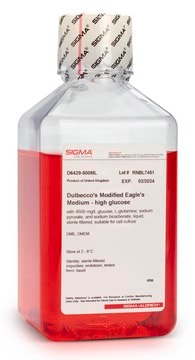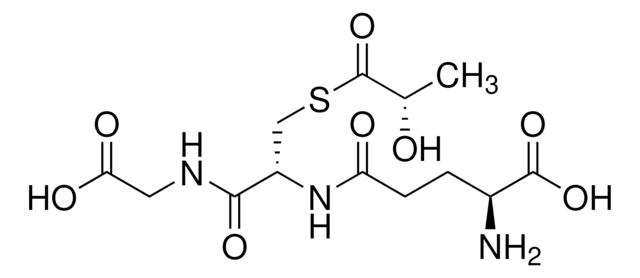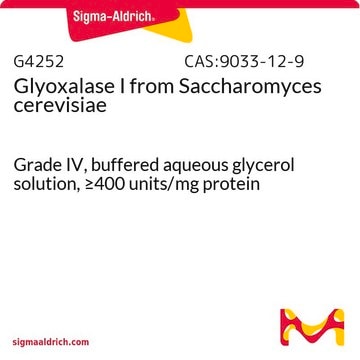Products may be shipped at a different temperature than the recommended long-term storage temperature. If the product quality is sensitive to short-term exposure to conditions other than the recommended long-term storage, it will be shipped on wet or dry-ice. If the product quality is NOT affected by short-term exposure to conditions other than the recommended long-term storage, it will be shipped at ambient temperature. As shipping routes are configured for minimum transit times, shipping at ambient temperature helps control shipping costs for our customers. For more information, please refer to the Storage and Transport Conditions document: https://www.sigmaaldrich.com/deepweb/assets/sigmaaldrich/marketing/global/documents/316/622/storage-transport-conditions-mk.pdf
Kluczowe dokumenty
M0252
Methylglyoxal solution
~40% in H2O
Synonim(y):
Acetylformaldehyde, Pyruvaldehyde, Pyruvic aldehyde
Wybierz wielkość
371,00 zł
Wybierz wielkość
About This Item
371,00 zł
Polecane produkty
Formularz
liquid
Poziom jakości
stężenie
~40% (enzymatic)
~40% in H2O
gęstość
1.17 g/mL at 25 °C (lit.)
temp. przechowywania
2-8°C
ciąg SMILES
[H]C(=O)C(C)=O
InChI
1S/C3H4O2/c1-3(5)2-4/h2H,1H3
Klucz InChI
AIJULSRZWUXGPQ-UHFFFAOYSA-N
Szukasz podobnych produktów? Odwiedź Przewodnik dotyczący porównywania produktów
Powiązane kategorie
Opis ogólny
Zastosowanie
- to assess glyoxalase 1 (GLO1) enzymatic activity[3][4]
- as an advanced glycation end (AGE) forming agent for the preparation of albumin in vitro[5]
- to regulate anxiety like behavior in mice[6]
- to induce peritoneal fibrosis in rats[7]
- to study the chromatographic retention characteristics of organic chemicals and metal DNA adducts[8]
- for intraplantar injection in mice to investigate peripheral and central components of methylglyoxal (MG)-transient receptor potential ankyrin 1 (TRPA1)-adenylyl cyclase 1 isoform (AC1) pathway[1]
Hasło ostrzegawcze
Danger
Zwroty wskazujące rodzaj zagrożenia
Zwroty wskazujące środki ostrożności
Klasyfikacja zagrożeń
Eye Dam. 1 - Met. Corr. 1 - Muta. 2 - Skin Sens. 1
Kod klasy składowania
8A - Combustible corrosive hazardous materials
Klasa zagrożenia wodnego (WGK)
WGK 1
Temperatura zapłonu (°F)
Not applicable
Temperatura zapłonu (°C)
Not applicable
Środki ochrony indywidualnej
Eyeshields, Faceshields, Gloves, type ABEK (EN14387) respirator filter
Wybierz jedną z najnowszych wersji:
Masz już ten produkt?
Dokumenty związane z niedawno zakupionymi produktami zostały zamieszczone w Bibliotece dokumentów.
Klienci oglądali również te produkty
Produkty
High-Performance Thin-Layer chromatography (HPTLC) quantification of methylglyoxal (MGO) in complex and matrix rich manuka honey offering quick sample preparation, high-matrix tolerance, and high-throughput.
-
How is shipping temperature determined? And how is it related to the product storage temperature?
1 answer-
Helpful?
-
-
How can I determine the shelf life / expiration / retest date of this product?
1 answer-
If this product has an expiration or retest date, it will be shown on the Certificate of Analysis (COA, CofA). If there is no retest or expiration date listed on the product's COA, we do not have suitable stability data to determine a shelf life. For these products, the only date on the COA will be the release date; a retest, expiration, or use-by-date will not be displayed.
For all products, we recommend handling per defined conditions as printed in our product literature and website product descriptions. We recommend that products should be routinely inspected by customers to ensure they perform as expected.
For products without retest or expiration dates, our standard warranty of 1 year from the date of shipment is applicable.
For more information, please refer to the Product Dating Information document: https://www.sigmaaldrich.com/deepweb/assets/sigmaaldrich/marketing/global/documents/449/386/product-dating-information-mk.pdfHelpful?
-
-
40%ということですが、25ml中10g程度のMGOが含まれるという理解でよろしいでしょうか。
1 answer-
The 40% approximation is mass/mass. In 25 grams of product, there will be 10 grams of methylglyoxal. The density of this preparation is 1.17 g/mL at 25 °C.
Helpful?
-
-
What are the mass and concentration of 25ML methylglyoxal solution?
1 answer-
As per the webpage of M0252: https://www.sigmaaldrich.com/product/sigma/m0252
The density is 1.17 g/mL at 25 °C (lit.). So the mass of 25 mL = 1.17 x 25 =29.25 g.
The concentration = Density x w/w% x 1000 / Molecular Weight = 1.17 x 40% x 1000 / 72.06 = 6.49 mol/L.Helpful?
-
-
Hi I am using this chemical for my research, could you please tell me the molarity of this solution?
1 answer-
The molarity of the Methylglyoxal solution is approximately 6.49 M. This value may be calculated as follows:
Molarity = Density x w/w% x 1000 / Mw = 1.17 x 40% x 1000 / 72.06 = 6.49 mol/LHelpful?
-
-
How to dilute methylglyoxal? What is the stock concentration?
1 answer-
The stock concentration will range from 4.89 M to 8.11 M, depending on the percent methylglyoxal - the specification ranges from 30 % to 50 %. The molecular weight of methylglyoxal is 72.06 g/mol.
Using the catalog density of 1.17 g/mL at 25 °C, the molarity would calculate to 6.49 molar for a 40 % solution (1,170 g/L × 0.40 = 468 g/L; 468 g/L divided by 72.06 = 6.49 M).
The actual % concentration is reported on the lot-specific Certificate of Analysis.
See the link below to access a specific lot or to review a sample Certificate:
https://www.sigmaaldrich.com/US/en/product/sigma/m0252#product-documentationThe solution is aqueous and may be further diluted in more water. If diluting with an organic solvent is preferred, ether or alcohols (i.e. ethanol, methanol) are also miscible with water.
Helpful?
-
-
Is the listed density, 1.17 g/ml, for the entire solution i.e. the Methylglyoxal in water or just the Methylglyoxal compound?
1 answer-
The density is 1.17 g/mL for the prepared solution.
Helpful?
-
Active Filters
Nasz zespół naukowców ma doświadczenie we wszystkich obszarach badań, w tym w naukach przyrodniczych, materiałoznawstwie, syntezie chemicznej, chromatografii, analityce i wielu innych dziedzinach.
Skontaktuj się z zespołem ds. pomocy technicznej
















